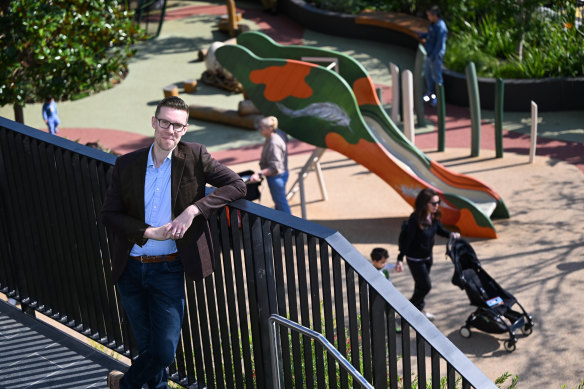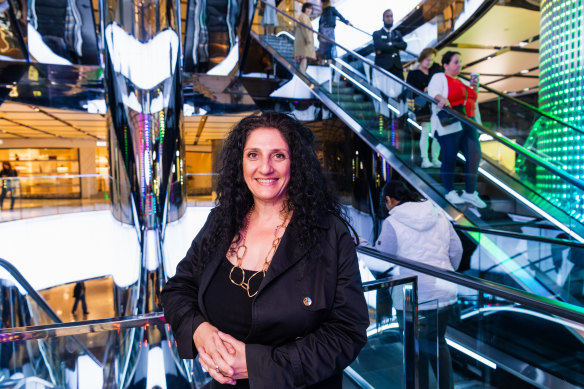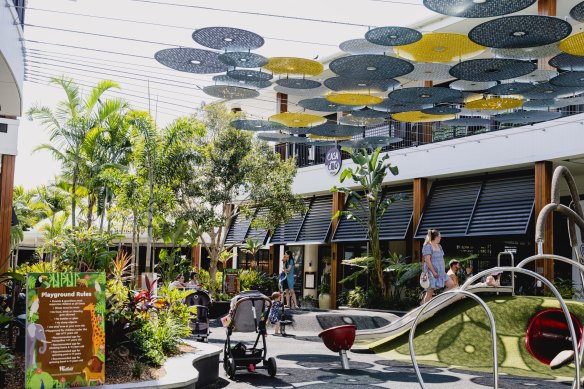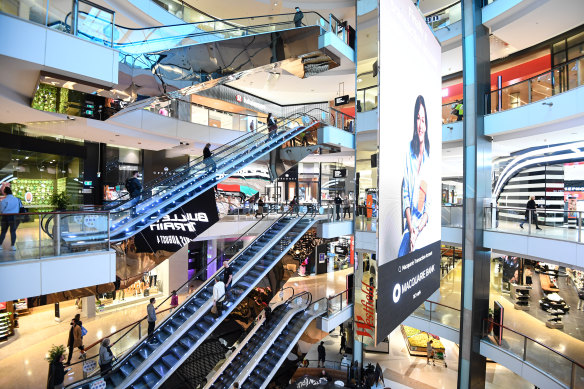
It is an unlikely location to discover the future of retail.
But a shopping centre in suburban Melbourne offers a glimpse into what lies ahead for shoppers as we increasingly buy products online and major retailers such as David Jones and Myer reduce their footprint or shut down stores.
Alongside its supermarkets and specialty stores, Westfield Knox also sports a basketball court, swim school, public library and a soon-to-open axe throwing bar.
“It’s also where my kids’ childcare is so it definitely is trying to be a town centre and give reasons for people to visit and dwell even if not shopping,” said Jason Pallant, senior lecturer in marketing at RMIT University.

Senior lecturer in marketing at RMIT University Jason Pallant near the playground at Westfield Knox.Credit: Joe Armao
Other shopping centres are moving beyond just shopping to offer entertainment, work spaces, community facilities and event homes.
“This really points to the rise of targeting consumers through unique experiences that can’t be fully replicated online as a reason to leave the house and visit a physical retail centre,” Pallant said.
Almost half of the stores in Westfield shopping centres are experience-based - dining, entertainment, health and wellness, fitness, beauty and education - that can only be consumed onsite.
Besides axe throwing in Melbourne, Westfield customers can lock themselves in a challenge room at Chermside in Brisbane, raise a sweat at Peloton in Bondi Junction or get tattoos at Tuggerah on the Central Coast and Southland in suburban Melbourne.
Mirvac offered pet Santa photos, cooking workshops and markets at Christmas at its shopping centres, which include Broadway Sydney and Birkenhead Point Outlet Centre.

Scentre Group director - customer, community and destinations, Lillian Fadel - said the majority of stores in Westfield shopping centres will be experience-based in five-to-10 years’ time. Credit: James Brickwood
A Mirvac spokeswoman said customers wanted “great hospitality, ambience, and something more – an exciting new brand, a workshop for the kids, an opportunity for improvement and personal development”.
“Now more than ever, real-life experiences are valued, and our customers are prioritising human interaction and genuine connection,” she said.
Shopping centre operator Scentre Group also offers free entertainment at Westfields, with appearances by Jessica Mauboy, Kate Ceberano and Amy Shark in the past year. It also teamed up with Disney to offer Star Wars experiences such as lightsabre training, craft activities and immersive video tours this month.
Scentre Group director customer, community and destinations Lillian Fadel said the company regarded shopping centres “more as destinations”.
“Customers see us as a destination to experience many things,” she said. “They value the convenience of being able to do the grocery shop, whilst their children are at swimming lessons or going to the gym and doing their beauty appointments on the way out.”
Loading
The transformation of shopping centres comes as major retailers, long regarded as a magnet for customers, reduce their bricks-and-mortar presence.
David Jones will shrink its footprint in two Sydney Westfields at Bondi Junction and Burwood.
A David Jones spokeswoman said the department store was refurbishing stores, “right-sizing” and, where necessary, consolidating footprints.
Myer shut stores in the Brisbane CBD and Frankston last year, after earlier shrinking or closing stores including in Hornsby on Sydney’s upper north shore and Belconnen in the ACT.
A Myer spokesman said customers want to shop across online and in store “and appreciate the ability to choose”.
Fadel said the departure of major retailers was an opportunity to repurpose space and make it more productive.
Scentre Group spent $355 million upgrading Westfield Knox following Myer’s departure in 2021, which Fadel said, “enabled us to reimagine the centre” and has boosted visitor numbers by 14 per cent.
“Rather than continuing to anchor it to a department store, we took guidance from the community to create our vision,” she said. “What you see today is a true destination and example of where we’re heading with our future investments.”

A Westfield mall in Chermside, Brisbane. Credit: Jamila Toderas
At Westfield Bondi Junction, high-end wellness and health operators, luxury stores and entertainment are likely to take over the space relinquished by David Jones, Fadel said.
Retailers are also offering experiences in a bid to lure customers - at Westfield Chatswood, Rebel Sport offers an augmented reality soccer pitch and basketball court alongside sporting equipment, shoes and fashion.
“In five-to-10 years’ time, we expect the majority of stores across our Westfield portfolio will be experience-based or have an experiential element,” Fadel said.
Data from commercial real estate services firm CBRE shows vacancy rates in shopping centres was 4.9 per cent in 2023, compared with 12.5 per cent in CBD retail across Australia.
Loading
CBRE also forecast shopping centre investment will grow by about 50 per cent from $4.2 billion in 2023 to an estimated $6.3 billion in 2025.
CBRE head of retail property management Sheree Griff said “experience retail” was fuelling growth in shopping centres.
“It could be experiencing a product brand and testing how it works - like a demonstration of cooking equipment, immersive sensory encounters, creative storytelling, food and beverage offerings or leaning into the luxury concierge service level where the customer feels special,” she said.
Online shopping has long been the enemy of bricks-and-mortar retail, yet Pallant said shopping centre operators are now embracing online and “its ability to empower educated shoppers”.
“These operators are blending the benefits of online with the unique advantages of physical environments through experiences, community services, and even tactical initiatives like click-and-collect,” he said.

Shoppers at Westfield in Bondi Junction.Credit: Peter Rae
At the same time, department stores have been shrinking or disappearing from shopping centres for several years as the need for big “all-in-one” shopping spaces declines, Pallant said.
“Retail is by no means dead, but it’s really about having a compelling reason to visit a physical space beyond buying things,” he said. “We could see that overlap with more showrooms for online-only brands that operate as spaces to trial products even if you don’t technically buy them in store.”
Retail historian Matthew Bailey, an associate professor at Macquarie University, said shopping centres in Australia have long sought to be more than just a collection of shops.
“Big regional shopping centres built by department stores in the 1960s in Australia included many cheap or free community services and spaces,” he said. “These were all rationalised away because they didn’t generate income.”
Singers such as John Farnham and Little Pattie performed at suburban shopping centres in Sydney in the 1960s, but Bailey said these events became less frequent “because they just clogged up the centres with people who didn’t end up spending a lot of money”.
More recently, Bailey said attempts to install indoor theme parks in Westfield shopping centres failed because they took up too much space for the revenue generated.
Loading
“Today, a bowling alley might be great fun, but it doesn’t generate the same rent as three jewellery shops and half a dozen fashion stores,” he said. “Balancing growth, an expanding scope of functions and convenience will be a delicate calculation moving forward.”
Bailey predicts shopping centres will house more services, entertainment and experiences to fill the space left by major retailers such as Myer, David Jones, KMart and Big W.
He does not believe Australia’s retail landscape will resemble the United States and be haunted by ghost malls.
“Australian shopping centres have been more resilient than US malls because they cater to a wider range of shopping trips and Australian planning regimes limit competition,” he said.









 Add Category
Add Category